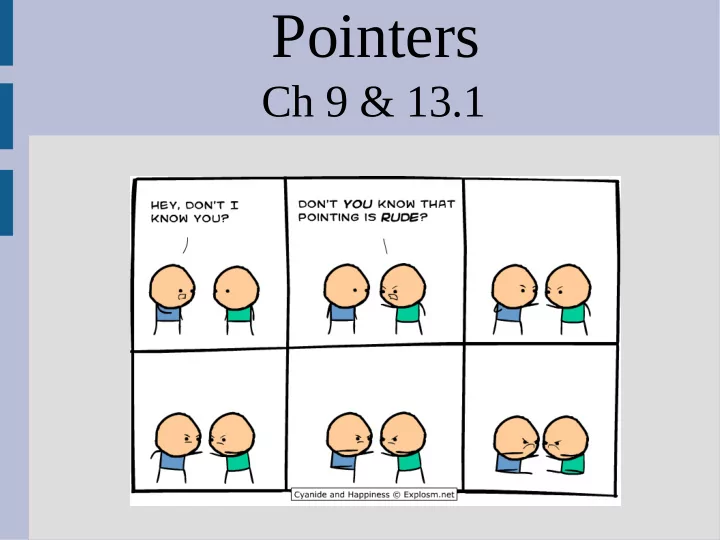

Pointers Ch 9 & 13.1
Highlights - pointers
object vs memory address An object is simply a box in memory and if you pass this into a function it makes a copy A memory address is where a box is located and if you pass this into a function, you can change the variable everywhere Memory address Object (box) arrays int, double, char, ... (pointers) using & classes
Review: address vs value Consider the following: x is a variable (a box containing value 6) &x is a memory address (sign pointing to box) - Rather than giving the value inside the box, this gives the whole box (see: memAddress.cpp)
Review: address vs value Similar to a URL and a webpage -A URL is not a webpage, but a link to one Webpage g; cout << &g;
Pointers Just as & goes from value (webpage) to address (url), * goes the opposite: Webpage g; &g *u URL u = &g; Webpage g2 = *u;
Pointers You can also think of pointers as “phone numbers” and what they point to as “people” Trump (object) 1-800-presdnt (pointer)
Pointers If multiple people have the same “phone number”, they call the same person (object) Trump (object) 1-800-presdnt 1-800-presdnt (pointer/ memory address)
Pointers A pointer is used to store a memory address and denoted by a * (star!) Here variable “xp” has type “integer pointer” The * goes from address to variable (e.g. like hitting ENTER on a url, or “call” on a phone contact) (See: pointerBasics.cpp)
Pointers (phone analogy) Make a contact name called “jacky” Make a phone-number for an person (int) Make a person (int) “Jacqueline Wu” exist (& = address of) Save Jacqueline Wu's phone number into the “jacky” contact Call the “jacky” contact (and * = call up connect with Jacqueline Wu)
Pointers It is useful to think of pointers as types: Here I declared a variable “xp” of type “int*” Just like arrays and [], the use of the * is different for the declaration than elsewhere: Declaration: the * is part of the type ( ) Everywhere else: * follows the pointer/address (i.e. puts 2 where xp is pointing to)
Pointers Pointers and references allow you to change anything into a memory address that you want This can make it easier to share variables across functions You can also return a pointer from a function (return links to variables) (see: returnPointer.cpp)
Pointers Why do we need pointers? (memory addresses are stupid!!!) Suppose we had the following class: Will this work?
Pointers As is, it will not... it is impossible to make a box enclose two other equal sized boxes The only way it can enclose something like itself is that thing is smaller
Pointers To do this we can use pointers instead! A pointer does not store the whole class data, it only remembers where it is (like a URL) (See: person.cpp) (more on this shortly)
-> When dealing with classes, often you need to deference (*) and access a member (.) There is a shortcut to de-reference and call a member (follow arrow and go inside a box) You can replace (*var).x with var->x, so... ... same as ...
Person class How would you make your grandmother? How could you get your grandmother using only yourself as a named object? (See: personV2.cpp)
Recommend
More recommend